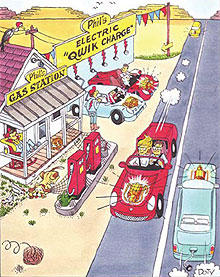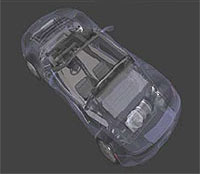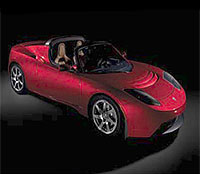Tesla Electric Roadster - Powered by Copper
 High-resolution version of this photo.
High-resolution version of this photo.Electric-powered cars have long been a dream for sci-fi writers, energy producers and automotive enthusiasts. In concept, this goal seems easily attainable, but for years inventors, entrepreneurs, and manufacturers alike have tried and ultimately failed to design a reliable and economically attractive electric vehicle. While the recent introduction of gas-electric hybrids has brought the vision closer to reality, the all-electric automobile has steadfastly remained a distant point on our automotive horizon.
This may be about to change. In July, Tesla Motors, a three-year old startup company based in San Carlos, California, introduced a prototype of its first all-electric automobile, the Tesla Roadster. A true sports car, the Roadster is hand-built, sleekly designed, fast and nimble. It boasts a range of 250 miles with a top speed of 130 mph. The company plans an initial production run of 100 vehicles at a cost of $100,000 per car, with the first automobile slated for delivery in the summer of 2007. Tesla Motors is the first of a number of enterprising companies who are bringing electric automobiles to the marketplace.
The Tesla Roadster is also the first commercially available automobile to incorporate an electric motor powered by a copper motor rotor. This innovative advancement in metallurgical technology increases efficiency, resulting in greater overall power and longer operating distances between charges.
GONE BUT NOT FORGOTTEN
Tesla Motors takes its name from Nikola Tesla, a brilliant pioneer in electrical research. Tesla was fascinated by the potential of electric automobiles, and in 1930 he tested his theories with a car that achieved a top speed of 90 miles an hour. Unfortunately, he kept the design of his engine to himself, and the secret of his remarkable electric automobile died with him in 1943.Even before Tesla, electric automobiles were not always absent from our roads. From the mid-1800s to the early twentieth century, electric cars were in high demand, and manufacturers like the Electric Car Company, Rauch & Long, and Detroit Electric produced thousands of vehicles a year to consumer acclaim. Unfortunately, the power cells used then were rudimentary, difficult to recharge, and limited automobiles to low speeds and short traveling distances.
By the end of World War I, improvements in the design of internal combustion engines, combined with the widespread availability of gasoline following the war, led to the demise of electric automobiles. Consumer demand dwindled and the electric car faded into time - until our present era's growing energy crisis sparked renewed interest.
Over the past decade, demand for increased fuel efficiency and reduced dependence on fossil fuels has resulted in new developments in electric automobile research. Lithium-based battery technology offers substantial improvement over heavy, cumbersome lead-acid batteries, providing greater power with faster charging times. In addition, many vehicle manufacturers now produce gas-electric hybrids powered by both electric and standard combustion engines. On average, these vehicles consume about half the amount of gasoline required by a typical automobile, and drive up to 70 miles on a gallon of gas.
Still, almost two-thirds of all the oil consumed in the U.S. is used for transportation, while global demand for oil is skyrocketing and supplies are dwindling. These stark realities led Martin Eberhard and Marc Tarpenning, two Silicon Valley entrepreneurs with a knack for bringing inventive ideas to the marketplace, to create Tesla Motors. The men believe they will succeed because their Roadster is based on a technology unavailable, until now, to other electric vehicle manufacturers - a lightweight, highly efficient copper motor rotor.
COPPER ROTORS AND EFFICIENCY
 Tesla's electric motor mounted in the back of the automobile features a copper motor rotor.
Tesla's electric motor mounted in the back of the automobile features a copper motor rotor. High-resolution version of this photo.
One of the key advantages of copper is its electrical conductivity. Good conductivity equals higher efficiency, as less of the power generated by the motor is lost due to resistance and heat. Most electric motors today use aluminum rotors that are not as efficient, but are easier to mass produce and less expensive, than their copper counterparts. Ounce for ounce, a copper rotor requires less material, compared to an aluminum rotor, to achieve the same level of performance.
Although engineers have long known about the potential of copper rotors, manufacturing difficulties and cost stymied their efforts to produce a workable design. Now, following years of research in die-cast mold design, a copper motor rotor as efficient to produce as it is to operate has become a reality. The successful effort was led by the Copper Development Association in the USA, along with a number of corporate partners and the U.S. Department of Energy, and funded by the International Copper Association.
The Tesla Roadster's mobility is provided by a three-phase electric motor with a low-resistance copper "squirrel cage" rotor - a cylindrical rotating component that creates the vehicle's kinetic energy. While typical internal combustion engines weigh several hundred pounds, the Tesla electric motor weighs just 70 pounds. The motor is powered by a proprietary battery pack that uses lithium-ion technology, which is easily recharged by plugging into any standard 120-volt electrical outlet.
According to Martin Eberhard, "One of the most important criteria in the design of the Tesla Roadster is energy efficiency. We would not have been able to achieve such outstanding results without the use of a copper motor rotor. The rotor enables us to offer an electric motor with exceptional torque and power with minimal resistance losses - all key components in meeting our design and performance goals."
Tesla Motors rates the energy efficiency of the Roadster by calculating its "well-to-wheel" efficiency, using a ratio that compares the cost of producing and transporting the fuel source, the energy produced by its combustion in the engine, and the automobile's emissions, which negatively affect the rate. Well-to-wheel efficiency on the Roadster prototype was measured against a number of currently available sports cars and hybrids. The Tesla engineers found that the Roadster offers double the efficiency of today's hybrids while producing only one-third of the emissions. Testing also revealed that, on the road, the Roadster offers the same performance and acceleration as a high-end sports car while consuming only one-sixth of the total energy.
THE FUTURE OF TESLA AND COPPER
Tesla's initial production of 100 vehicles sold out within weeks and the company is already taking reservations for the next 100 vehicles to be built. Encouraged by this response, Tesla engineers are hard at work on a four-person sedan expected to debut in 2009.
"The electric car is a key to our energy independence and our future," Eberhard believes. "We expect copper to continue to lead the way for our high-performance electric automobiles." Cu
Resources:
Also in this Issue:
- Tesla Electric Roadster - Powered by Copper
- Copper - An Antiaging Element
- Can Copper Increase Brainpower?
- Ultrahigh-speed Copper Ethernet Standard Approved
- Wind Power for Home Heating

 The Tesla Roadster
The Tesla Roadster